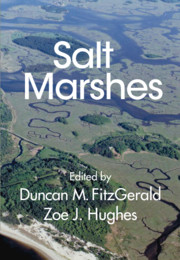Book contents
- Salt Marshes
- Salt Marshes
- Copyright page
- Contents
- Contributors
- Acknowledgments
- 1 State of Salt Marshes
- Part I Marsh Function
- Part II Marsh Dynamics
- 7 Marsh Equilibrium Theory
- 8 Salt Marsh Ecogeomorphic Processes and Dynamics
- 9 Salt Marsh Sediments as Recorders of Holocene Relative Sea-Level Change
- 10 Storm Processes and Salt Marsh Dynamics
- 11 Understanding Marsh Dynamics
- 12 Understanding Marsh Dynamics
- Part III Marsh Response to Stress
- Index
- References
10 - Storm Processes and Salt Marsh Dynamics
from Part II - Marsh Dynamics
Published online by Cambridge University Press: 19 June 2021
- Salt Marshes
- Salt Marshes
- Copyright page
- Contents
- Contributors
- Acknowledgments
- 1 State of Salt Marshes
- Part I Marsh Function
- Part II Marsh Dynamics
- 7 Marsh Equilibrium Theory
- 8 Salt Marsh Ecogeomorphic Processes and Dynamics
- 9 Salt Marsh Sediments as Recorders of Holocene Relative Sea-Level Change
- 10 Storm Processes and Salt Marsh Dynamics
- 11 Understanding Marsh Dynamics
- 12 Understanding Marsh Dynamics
- Part III Marsh Response to Stress
- Index
- References
Summary
Marshes have long been considered useful for their ecosystem service of coastal protection. Their roles in protection from storms and floods are seen as necessary and important to many coastal communities (Barbier et al. 2011; Costanza et al. 1997; Millennium Ecosystem Assessment. 2005; Morgan et al. 2009). Understanding the impacts that storms have on coastal ecosystems and adjacent coastal communities is imperative to increasing coastal resilience in the face of future increases in coastal flooding and associated damage (Mendelsohn et al. 2012; Pielke et al. 2008). Salt marshes have been lauded as buffers to storm surges, wind-generated waves, and elevated water levels (French 2006; Möller 2012). The ecological restoration economy, which includes salt marsh restoration, in the USA alone generates $9.5 billion in annual economic output and employs an estimated 126,000 workers (BenDor et al. 2015). After Hurricane Sandy, the US Fish and Wildlife Service spent more than $40 million on salt marsh restoration projects in response to this single event, including $11 million toward restoring a series of salt marshes along Long Island.
- Type
- Chapter
- Information
- Salt MarshesFunction, Dynamics, and Stresses, pp. 257 - 277Publisher: Cambridge University PressPrint publication year: 2021

